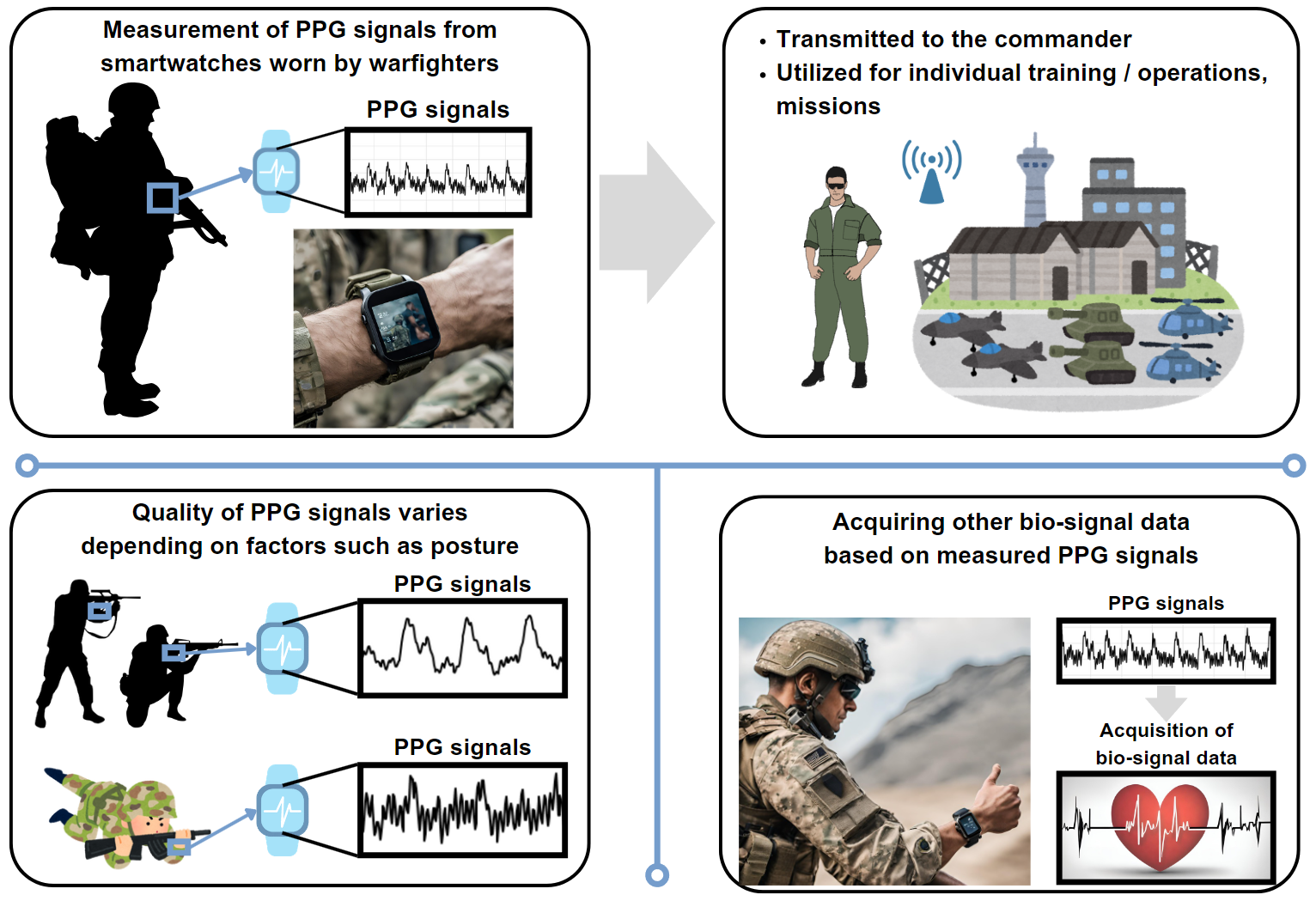Measurement inaccuracy of wearable photoplethysmogram in military smartwatch
DOI:
https://doi.org/10.37944/jams.v7i1.234Keywords:
Army TIGER 4.0, wearable device, military smartwatch, Photoplethysmogram (PPG) measurement error, biometric dataAbstract
As the military adopts wearable devices, soldiers use them to check their own health and perform operations. Under these conditions, measurement errors in military smartwatches can significantly affect soldier safety and survival. Photoplethysmogram (PPG) measurement errors may arise from various factors including the physical condition of the user, contact point, and environmental conditions. In particular, soldiers may experience rapid changes in their heart rates owing to intense training and operational activities. In such situations, errors in PPG measurements may pose challenges in accurately assessing the health status of soldiers. Therefore, enhancing PPG measurement functionality using wearable devices is important to accurately assess the health status, improve survivability, and enhance the operational performance of soldiers on the battlefield. Consequently, research and development in this area are necessary. Thus, our study examined the factors contributing to potential PPG measurement errors in smartwatches, assessed the extent of these errors, and discussed approaches to improve and mitigate them.
Metrics
References
Almarshad, M. A., Islam, M. S., Al-Ahmadi, S., & BaHammam, A. S. (2022). Diagnostic features and potential applications of PPG Signal in Healthcare: A systematic review. Healthcare, 10(3), 547. https://doi.org/10.3390/healthcare10030547
Armañac-Julián, P., Kontaxis, S., Rapalis, A., Marozas, V., Laguna, P., Bailón, R., Gil, E., & Lázaro, J. (2022). Reliability of pulse photoplethysmography sensors: Coverage using different setups and body locations. Frontiers in Electronics, 3, 1-11. https://doi.org/10.3389/felec.2022.906324
Bariya, M., Nyein, H. Y., & Javey, A. (2018). Wearable sweat sensors. Nature Electronics, 1(3), 160–171. https://doi.org/10.1038/s41928-018-0043-y
Chan, Cooper, Hosanee, Welykholowa, Kyriacou, Zheng, Allen, Abbott, Lovell, Fletcher, & Elgendi. (2019). Multi-site photoplethysmography technology for Blood Pressure Assessment: Challenges and Recommendations. Journal of Clinical Medicine, 8(11), 1827. https://doi.org/10.3390/jcm8111827
Derler, S., Rossi, R., & Rotaru, G. M. (2014). Understanding the variation of friction coefficients of human skin as a function of skin hydration and interfacial water films. Proceedings of the Institution of Mechanical Engineers, Part J: Journal of Engineering Tribology, 229(3), 285–293. https://doi.org/10.1177/1350650114527922
Ebrahimi, Z., & Gosselin, B. (2023). Ultralow-power photoplethysmography (PPG) sensors: A methodological review. IEEE Sensors Journal, 23(15), 16467–16480. https://doi.org/10.1109/jsen.2023.3284818
El-Zaiat, S. Y. (2003). Interferometric determination of refraction and dispersion of human blood-serum, saliva, sweat and urine. Optics & Laser Technology, 35(1), 55-60. https://doi.org/10.1016/s0030-3992(02)00144-5
Ghosh, S., Banerjee, A., Ray, N., Wood, P. W., Boulanger, P., & Padwal, R. (2016). Continuous blood pressure prediction from pulse transit time using ECG and PPG Signals. 2016 IEEE Healthcare Innovation Point-Of-Care Technologies Conference (HI-POCT). https://doi.org/10.1109/hic.2016.7797728
Jang, B. J., Cho, J. H., Kim, D. H., & Park, K. W. (2023). Development of an IMU-based Wearable Ankle Device for Military Motion Recognition. Journal of Intelligence and Information Systems, 29(2), 23-34. https://doi.org/10.13088/jiis.2023.29.2.023
Jong, G. J., Aripriharta, & Horng, G. J. (2017). The PPG physiological signal for heart rate variability analysis. Wireless Personal Communications, 97(4), 5229–5276. https://doi.org/10.1007/s11277-017-4777-z
Kim, D. H. (2023). A Study on the Development Direction of Weapon Systems Using Wearable Devices for Future Military Combatants. Journal of Korea Academia-Industrial cooperation Society, 24(2), 576-582. https://doi.org/10.5762/KAIS.2023.24.2.576
Lee, G. H., Kang, H., Chung, J. W., Lee, Y., Yoo, H., Jeong, S., Cho, H., Kim, J.-Y., Kang, S.-G., Jung, J. Y., Hahm, S. G., Lee, J., Jeong, I.-J., Park, M., Park, G., Yun, I. H., Kim, J. Y., Hong, Y., Yun, Y., … Choi, B. K. (2022). Stretchable PPG Sensor with light polarization for physical activity–permissible monitoring. Science Advances, 8(15). https://doi.org/10.1126/sciadv.abm
Lee, S. B. (2017). A Study on the Psychological Stability of Soldiers in the Early Stage War and Improvement Plan to Uplift Fighting Spirit. Korea Journal of Military Affairs, 1, 181-218. https://doi.org/10.33528/kjma.2017.06.1.181
Lee, S. M., Lee, M. R., Wei Qun, & Park, H. J. (2022). Development of a Multi-Modal Physiological Signals Measurement-based Wearable Device for Heart Sounds Analysis. JOURNAL OF KOREA MULTIMEDIA SOCIETY, 25(9), 1251-1256. https://doi.org/10.9717/kmms.2022.25.9.1251
Liu, Y., Pharr, M., & Salvatore, G. A. (2017). Lab-on-skin: A review of flexible and Stretchable Electronics for wearable health monitoring. ACS Nano, 11(10), 9614–9635. https://doi.org/10.1021/acsnano.7b04898
Namvari, M., Lipoth, J., Knight, S., Jamali, A. A., Hedayati, M., Spiteri, R. J., & Syed-Abdul, S. (2022). Photoplethysmography enabled wearable devices and stress detection: A scoping review. Journal of Personalized Medicine, 12(11), 1792. https://doi.org/10.3390/jpm12111792
Nardelli, M., Vanello, N., Galperti, G., Greco, A., & Scilingo, E. P. (2020). Assessing the quality of heart rate variability estimated from wrist and finger PPG: A novel approach based on cross-mapping method. Sensors, 20(11), 3156. https://doi.org/10.3390/s20113156
Razavi, B. (2020). The Z-transform for analog designers [the analog mind]. IEEE Solid-State Circuits Magazine, 12(3), 8–14. https://doi.org/10.1109/mssc.2020.3002137
Sarhaddi, F., Kazemi, K., Azimi, I., Cao, R., Niela-Vilén, H., Axelin, A., Liljeberg, P., & Rahmani, A. M. (2022). A Comprehensive Accuracy Assessment of Samsung Smartwatch Heart Rate and Heart Rate Variability. PLoS One, 17(12), e0268361. https://doi.org/10.1101/2022.04.29.22274461
Seo, H., & Jeong, S. (2022). Improvement of combat readiness for Republic of Korea Army. Journal of Advances in Military Studies, 5(3), 131-153. https://doi.org/10.37944/jams.v5i3.172
Won, K., Kim, Y., Kim, M., Ha, T., Lee, Y., & Lee, H. (2021). Future and development direction (21-35) of M&S for building up to the hyper-army in Republic of Korea Army: Focusing on fostering high-tech armed forces. Journal of Advances in Military Studies, 4(2), 37-58. https://doi.org/10.37944/jams.v4i2.113
Xiong, Y., Zhang, X., Ma, X., Wang, W., Yan, F., Zhao, X., Chu, X., Xu, W., & Sun, C. (2021). A review of the properties and applications of bioadhesive hydrogels. Polymer Chemistry, 12(26), 3721–3739. https://doi.org/10.1039/d1py00282a
Yamakoshi, T., Lee, J., Matsumura, K., Yamakoshi, Y., Rolfe, P., Kiyohara, D., & Yamakoshi, K. (2015). Integrating sphere finger-photoplethysmography: Preliminary investigation towards practical non-invasive measurement of blood constituents. PLoS One, 10(12). https://doi.org/10.1371/journal.pone.0143506

Downloads
Published
How to Cite
Issue
Section
License
Copyright (c) 2024 Journal of Advances in Military Studies

This work is licensed under a Creative Commons Attribution 4.0 International License.

This work is licensed under a Creative Commons Attribution 4.0 International License.

이 저작물은 크리에이티브 커먼즈 저작자표시 4.0 국제 라이선스에 따라 이용할 수 있습니다.






